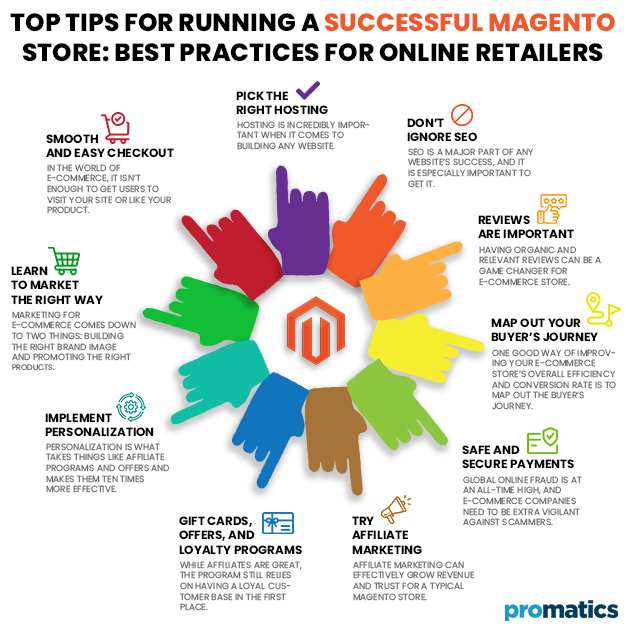Maximizing Your Magento Store’s Potential: Best Practices for Running a Successful Online Retail Business
The e-commerce industry has exploded recently, more so since the pandemic. The global retail e-commerce industry is expected to be worth 7.4 trillion dollars by 2025. This rapid, industry-wide growth has been spearheaded not by retail giants like Amazon or Walmart but by localized, niche players and small-scale online retailers.
But competition in a saturated market isn’t always easy for these smaller stores. E-commerce is difficult, and keeping up with all the upcoming tech can be a big challenge. Thankfully, E-commerce developers and tools like Magento have come to the rescue. Magento is a powerful tool that offers a complete e-commerce solution, provided you know how to make the best of it. So if you are a Magento user or someone considering building an online store, here are ten best practices to get the most out of your Magento store.
What is Magento?
Magento is a complete E-commerce platform solution designed to help users build e-commerce stores/websites from scratch, capable of selling directly to customers online. Magento, owned by Adobe, comes in two versions: One being an open source, self-hosted, free version of Magento; and another being Adobe e-commerce, which includes everything from open source Magento plus a few additional features, all hosted on Adobe’s hosting.
Magento allows businesses to set up shop online and has played a pivotal role in making E-commerce more accessible and lowering the barrier to entry for smaller players. Thanks to platforms like Magento, anyone with an internet connection and an online presence can sell online. Magento offers features like site management and SEO optimization, catalog production and management, order management, and even payment and shipping, making it a complete solution for e-commerce retailers and businesses.
So if you are among the approximately 170000 sites that rely on Magento, it is important to learn to make the most out of Magento to ensure your e-commerce store runs at its peak efficiency. To help you do the same, here are 10 effective best practices for running a successful e-commerce store with Magento:
10 Practices for Running a Successful Magento Store
Magento is a great platform with a long list of features designed to help you build a profitable online store. However, Magento is just a tool, and businesses must learn to use it effectively if they wish to unlock its true potential. Here are 10 best practices to help you make the most out of your Magento installation.
1. Pick the Right Hosting
Hosting is incredibly important when it comes to building any website. And it is especially critical for e-commerce stores, where speed, volume, and safety are paramount. When picking a hosting service for your Magento store, it is advised to opt for a reliable solution that offers maximum up-time and is scalable. Cheaper hosting services may offer a good deal early on, but as your store grows, these may end up limiting its performance, given limited data storage and bandwidth. Ultimately, businesses and vendors with a higher budget can also opt for the paid version of Magento with Adobe’s hosting, simplifying the process of finding the right hosting service.
2. Don’t Ignore SEO
SEO is a major part of any website’s success, and it is especially important to get it right for e-commerce stores that operate in saturated markets. Investing in improving your SEO performance can go a long way since it is essentially the only way your products can compete against retail giants. For an E-commerce store just starting out with SEO optimization, it is best if they focus on niche products. Meaning smaller brands must identify their top-selling products and double down on being the best within the said product categories. From an SEO perspective, optimizing your site and your catalog for speed and usability, being strategic with keyword selection for your niche category, producing high-quality backlinks, and propelling trust-generating content higher up in SERPs can be a good way to get started. For a more in-depth guide to Magento SEO, read Moz’s post here.
3. Reviews are Important
Generating trust is critical for any Magento store’s success. And putting out user-generated content in the form of reviews and rating is the best way to generate trust for your e-commerce brand. But getting real and positive reviews from your users can be a challenge. Magento stores can encourage users to leave reviews for their last purchases using pop-ups or strategic call-to-actions to get around this challenge. Or stores can go as far as directly incentivizing their users to leave reviews, offering discounts and offers in return. And finally, the best way to get reviews on your e-commerce store is to prioritize exceptional service, both on the product and the fulfillment side. Having organic and relevant reviews can be a game changer for e-commerce stores, so make sure you invest in getting these.
4. Map Out Your Buyer’s Journey
One good way of improving your e-commerce store’s overall efficiency and conversion rate is to map out the buyer’s journey, from product search to check out, on your E-commerce store. Mapping out your customer journey includes identifying every touch point where a potential customer can interact with your brand and ways of improving the interaction to maximize trust and conversion. Understanding how customers perceive and interact with your brand can help build an efficient sales funnel.
5. Safe and Secure payments
Global online fraud is at an all-time high, and e-commerce companies need to be extra vigilant against scammers since they can not only eat into their profits but also erode customer trust. Online payments make up most of the payments to an e-commerce store. This is why you must ensure all your payment gateways are safe and secure. Magento encourages using trusted and secure payment gateways like PayPal on their store. Still, the most important thing to remember here is that your store must comply with the PCI DSS guidelines. These are a set of requirements that all payment partners must follow to ensure safe transactions. Magento, by default, comes with a PCI-compliant payment method named Enterprise Payment Bridge. Installing alternative, non-compliant payment systems can put you at risk.
6. Try Affiliate Marketing
Affiliate marketing can effectively grow revenue and trust for a typical Magento store. Affiliates are great because they boost your sales in the short term and act as an effective marketing tool in the long term. Affiliates are a great way of turning your loyal customers into brand advocates, a relationship that benefits both parties. When starting with an Affiliate program, it is important to calculate your ROI on affiliates, offer only sales-based commissions, and make it as easy as possible for affiliates to put your products out there. Magento has access to a wide variety of plugins that make it easy to run an affiliate program through your site.
7. Gift cards, offers, and Loyalty programs
While affiliates are great, the program still relies on having a loyal customer base in the first place. But what if your Magento store is relatively young or in the process of launching a new product line? In these cases, discounts and loyalty programs can go a long way. Discounts help attract new customers, and loyalty programs make sure that they stay. Together, they make up an excellent customer acquisition system that can build you a massive customer base. When implementing a loyalty program, ensure you have a clear and easy-to-understand reward point system. Again, Magento users have access to a wide range of plugins and extensions that they can install on their stores that allow them to implement flexible loyalty programs.
8. Implement Personalization
Personalization is what takes things like affiliate programs and offers and makes them ten times more effective. Personalization is all about taking the available user data and using it to offer more relevant discounts, offers, and rewards. Magento 2 comes with a ton of in-built personalization options like segmentation. You can divide users into categories or segments using buying behavior and use features like recommending related products and custom pricing to make their shopping experience better. Once again, extensions allow store owners to have deeper personalization if they choose to. However, implementing true personalization can be difficult for your average business. Though Magento 2 is a lot more user-friendly than the previous iteration, brands might still consider hiring e-commerce development companies to implement personalization.
9. Learn to Market the Right Way
Marketing for e-commerce comes down to two things: building the right brand image and promoting the right products. You can achieve these goals by relying on a multichannel marketing strategy. Use channels like social media and PPC ads to put out products related details and offers. Use channels like email marketing to personalize your communication with your customer from brand building.
10. Smooth and Easy Checkout
In the world of e-commerce, it isn’t enough to get users to visit your site or like your product. While most users might consider buying your product, around 70% of all products added to the cart are abandoned. It is advised that stores make the checkout process as smooth and easy to follow as possible to minimize their cart abandonment rate. Magento allows for single-page checkouts, ensuring that users can pay as fast as possible without giving up on intermediate steps. It also helps to make the checkout process login-independent and mobile-friendly. Finally, allow multiple payment options to allow users to pay using their preferred payment method.
Conclusion
Running an e-commerce store isn’t easy, but with tools like Magento, the process becomes a lot easier and more manageable. Remember, running an online store is all about prioritizing your customer’s needs and optimizing your Magento store to do the same. Magento is a fully independent solution for businesses seeking a complete e-commerce solution, but businesses need to understand its features and how to use them to make the most of it. Hope the tips mentioned above can help you take your Magento store to the next level.
Still have your concerns?
Your concerns are legit, and we know how to deal with them. Hook us up for a discussion, no strings attached, and we will show how we can add value to your operations!

